
A navel piercing is a type of piercing located through the skin of the navel. It is most commonly located on the upper fold of skin, but can also be effected underneath or around the edges of the navel. It may heal quickly and with no irritations, like an ear piercing, or may heal more like a surface piercing with the associated extended healing time. Healing usually takes around 6–12 months, but varies by person due to differences in physiology. Navel piercings reject less frequently than most other surface piercings, but the rejection rate is nonetheless higher than non-surface piercings. A properly effected navel piercing involves piercing the skin surrounding the navel with the initial wound inside of the navel canal. This can be done at any angle where there is a clear flap of skin, but the most prevalent form of navel piercing is through the upper rim of the navel.

A clitoral hood piercing is a female genital piercing through the clitoral hood surrounding the clitoris. The clitoral hood is homologous with the foreskin in the male reproductive system. In addition to being an adornment, a clitoral hood piercing can enhance sexual pleasure during masturbation, foreplay and intercourse. In an empirical study at the University of South Alabama, the authors reported a positive relationship between vertical clitoral hood piercings and desire, frequency of intercourse, and sexual arousal. There are two main types of clitoral hood piercing: the vertical clitoral hood (VCH) piercing and the horizontal clitoral hood (HCH) piercing. As the names indicate, the difference is in the direction the piercing is oriented in the skin above the clitoris. Neither of these piercings penetrates the clitoris itself, although in common parlance they are sometimes called "clit" piercings. The deep hood piercing is a variation of the clitoral hood piercing that passes deeper through the clitoral hood.

Nose piercing is the piercing of the skin or cartilage which forms any part of the nose, normally for the purpose of wearing jewelry, called a nose-jewel. Among the different varieties of nose piercings, the nostril piercing is the most common.

A dydoe is a type of male genital piercing that passes through the ridge of the glans on the head of the penis. They are often done in pairs. Less often, a "king's crown" is where several dydoes are placed around the head of the penis. The jewelry is usually a 12 gauge, straight barbell with a ball on either end, although a ring may be used at a higher chance of rejection. A deep dydoe is one that uses a longer barbell and exits near the tip of the penis.
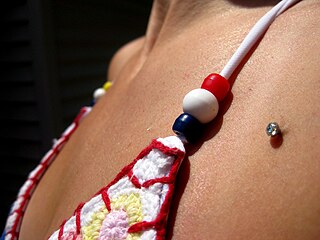
Transdermal implants, or dermal piercings, are a form of body modification used both in a medical and aesthetic context. In either case, they consist of an object placed partially below and partially above the skin, thus transdermal. The skin around it generally heals as if it were a piercing.

A Christina piercing, also known as a Venus piercing, is a female genital piercing. It is located where the outer labia meet, below the pubic mound. The Christina piercing is anatomy dependent; it has a high rejection rate, and is not possible for all women due to anatomical variation. If the flesh above the clitoris where the outer labia meet is fleshy enough to pinch, a Christina piercing may be successful. If the flesh in this area is too tight to pinch, a Christina piercing is contraindicated. The piercing does not facilitate sexual stimulation and can be found uncomfortable when pressure is applied. It is usually pierced with either a custom-made curved barbell or surface bar to reduce the risk of rejection.

Surface piercings are piercings that are found on flat parts of the body, giving a double-pierced look that sits flat against the skin. A surface bar follows the plane of skin, while a standard piercing is pierced through the plane. Standard piercings have an entrance hole with an exit hole that is usually directly behind the entrance hole, whereas with a surface piercing the entrance and exit holes are next to each other on the skin surface.
A transscrotal piercing is a body piercing that travels through the scrotum from front to back, or from side to side. It is a high risk procedure.

An industrial piercing, also known as a scaffold piercing (UK/Ireland) or construction piercing, is any ear piercing that consists of two pierced holes connected with a single piece of jewelry. These piercings typically consist of a double perforation of the upper ear cartilage specifically. Two piercings must be made: one is fairly close to the head, while the second one is further down the helix on the opposite side of the ear. Industrial piercings that are vertical are also known as a suicide industrial.
Stretching, in the context of body piercing, is the deliberate expansion of a healed piercing for the purpose of wearing certain types of jewelry. Ear piercings are the most commonly stretched piercings, with nasal septum piercings, tongue piercings and lip piercings/lip plates following close behind. While all piercings can be stretched to some degree, cartilage piercings are usually more difficult to stretch and more likely to form hypertrophic scars if stretched quickly. Dermal punching is generally the preferred method for accommodating larger jewelry in cartilage piercings.
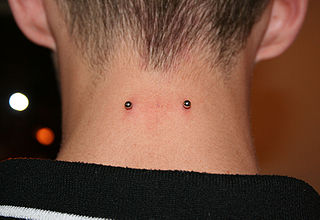
A nape piercing is a piercing through the surface of the nape of the neck. Nape piercings are a type of surface piercing. They carry a high rate of rejection and migration, unless they are properly measured and placed. They may reject if they are not pierced properly, as they are in a part of the body that moves constantly and are easy to irritate, catching on clothing or other objects.
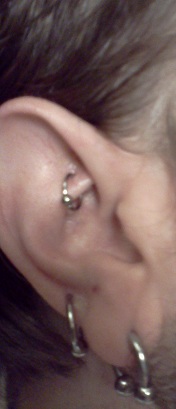
A rook piercing is a perforation of the antihelix of the ear for the purpose of wearing jewelry. It is located just above the tragus on the ridge between the inner and outer conch with the piercing passing from the underside to the top of this ridge, differing from many ear piercings that essentially span between a "front" and "back" surface. Erik Dakota, a well known professional piercer and the individual responsible for originating and popularizing the rook piercing, is said to have named this modification after a shortened version of his first name. The piercing was first named in issue #4 of the magazine Body Play and Modern Primitives Quarterly around 1992 alongside the first printed reference to the industrial piercing, then termed "industrial ear project".

Piercing migration is the process that occurs when a body piercing moves from its initial location. This process can be painful or go unnoticed, until it has progressed. Given enough time, a ring may migrate entirely outside of the skin, although it may only migrate a small amount and come to rest.

A corset piercing is a body piercing that consists of multiple piercings in rows, usually on the back, with ribbon or string laced through to mimic the appearance of a corset. Two rows of bilaterally symmetrical piercings are performed and can be composed of as few as four piercings or as many as the length of the area being pierced and the vertical space between piercings will allow space for. Due to the difficulty and risks associated with permanently healing single surface piercings, most corset piercings are intended to be temporary.
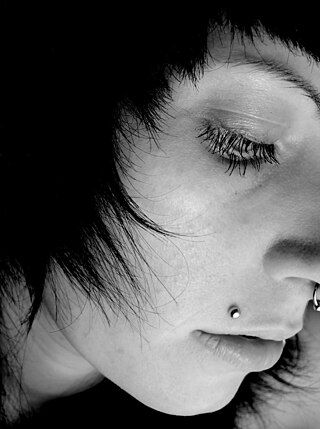
A Monroe piercing is a lip piercing placed off-center, above the upper lip on the left-hand side and is meant to resemble Marilyn Monroe's beauty spot, although Monroe's beauty spot was on her cheek, not her lip. The Madonna piercing is similar but worn on the right-hand side.

An orbital piercing is a combination of two ear piercings connected by one piece of jewelry. Usually located in the helix region of the ear, an Orbital Piercing can be done anywhere on the body including your earlobes. The piercing uses a hoop, and is not to be confused with an industrial piercing, a conch piercing or double cartilage piercing.

In body modification, an implant is a device that is placed under the human skin for decorative purposes. Such implants may be subdermal or transdermal. In the context of body modification, some may consider injections of silicone and other substances a type of implant as well.
A wrist piercing is a piercing through the surface of the wrist, first popularized by Jon Cobb in PFIQ. Wrist piercings are a type of surface piercing. They carry a high rate of rejection and migration, unless they are properly measured and placed. The piercings may be rejected if they are not installed properly; due to the location of the piercings they are easy to irritate, and regularly catch onto clothing or other objects. People with wrist piercings are advised to put on short sleeved t-shirts, singlets so as to prevent the surface barbell from catching onto the threads of the clothing. Also, wrist piercings can only be done with a special tool and thus, it is of high difficulty for it to be home-made. Piercers would also advise that, after getting a wrist piercing, the person is to soak and moisten the wound with mild salted solution so as to disinfect the area, preventing bacteria from entering the unclotted wound. The span of a wrist piercing ranges approximately from as short as 2 weeks to 6 or 7 months.

Body piercing, which is a form of body modification, is the practice of puncturing or cutting a part of the human body, creating an opening in which jewelry may be worn, or where an implant could be inserted. The word piercing can refer to the act or practice of body piercing, or to an opening in the body created by this act or practice. It can also, by metonymy, refer to the resulting decoration, or to the decorative jewelry used. Piercing implants alter the body and/or skin profile and appearance. Although the history of body piercing is obscured by popular misinformation and by a lack of scholarly reference, ample evidence exists to document that it has been practiced in various forms by multiple sexes since ancient times throughout the world. Body piercing can be performed on people of all ages, although most minors are only permitted to have earlobe piercings.
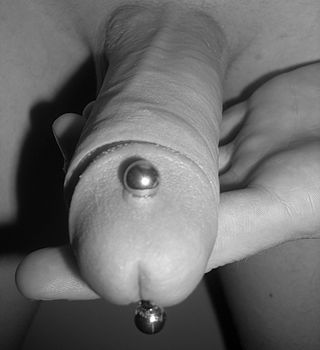
The apadravya, like the ampallang, is a genital piercing that passes through the glans. While the ampallang passes horizontally through the glans, the apadravya passes vertically through the glans from top to bottom, almost always placed centrally and passing through the urethra. It can be paired with an ampallang to form the magic cross. Off-center apadravyas are also possible, wherein the piercing is deliberately offset, yet usually still passes through the urethra. The piercing is often done on a slightly forward angle to the hips.
















